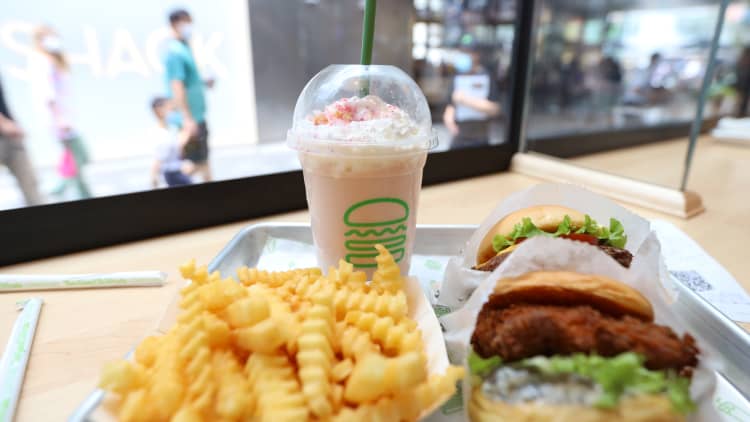A group of guys enjoy a dinner at Cassias outdoor patio as the much loved restaurant re-opens its indoor dining and continues outdoor dining on Wednesday, May 5, 2021 in Santa Monica, CA.
Jason Armond | Los Angeles Times | Getty Images
Consumers aren’t sacrificing dining out, even with prices on the rise — but they are getting more savvy about managing those bills.
The majority of Americans surveyed, 81%, say they are dining out once a month or more and 31% say they dine out once a week or more, according to new research from e-commerce provider Lightspeed Commerce Inc.
Even though inflation has slowed significantly from its pandemic-era peak, consumers still feeling the financial squeeze are opting for takeout, value meals and happy hour deals, the report found.
The consumer price index, which gauges how fast prices are changing in the U.S. economy, shows food prices at restaurants have been growing faster than grocery store items — but finance experts have tips for stretching your dollar.
“While Americans are still dining out, they are also looking for ways to keep dining fun and affordable amidst changing economic conditions. It’s all about value for diners — they’re looking to enjoy eating out, but at a good price,” Lightspeed CEO Dax Dasilva said.
Lightspeed surveyed 1,500 Americans in May as part of an international survey that included 7,500 overall responses.
Higher meal prices and ‘shrinkflation’
U.S. diners are noticing rising prices when the server drops off their bill, with 69% in the Lightspeed survey reporting pricier meals. Some said they’re seeing “shrinkflation” in action, with 39% noticing their favorite dishes shrinking in size even as the prices remain the same or increase.
Even with a jump in prices, about half of respondents said they will continue to dine out at the same rate or increase their frequency of restaurant visits.
Ted Jenkin, a certified financial planner and CEO of oXYGen Financial Inc. in Atlanta, said consumer dining trends could be a lingering effect from the aftermath of the pandemic.
More from Personal Finance:
Here’s why your July 4th barbecue may be pricier this year
Biden’s new student loan relief plan is on pause. What to know
Homeowners typically spend nearly $55,000 to sell a home
“It started with revenge travel, and then it was followed by revenge shopping. And now I think it’s just a way that people are living their life with this mentality of ‘I’m going to just enjoy my life today, because I don’t know what tomorrow is going to bring me,'” said Jenkin, who is a member of the CNBC Advisor Council. “And I think there’s been some permanency to that.”
Nearly half of U.S. diners, 45%, are being more frugal by asking for to-go boxes to enjoy leftovers later, according to Lightspeed. Meanwhile, 43% are hunting for deals with coupons, 39% are choosing value meals and 36% are taking advantage of happy hour specials.
Past the ‘tipping point of tipping’
One way consumers say inflation is impacting their dining habits is through tipping. Of those surveyed, 44% of consumers said inflation has affected their ability to tip.
The majority of diners surveyed, 73%, say they’re not happy when the cashier flips around a tablet screen to reveal auto-tipping options.
“I think when times were better, you definitely saw more people being more comfortable at the iPad paying tip,” said Winnie Sun, co-founder and managing director of Irvine, California-based Sun Group Wealth Partners. She is also a member of the CNBC Advisor Council.
“Nowadays, consumers are fed up with having to tip at places that they don’t normally tip at,” she added.
When looking at scenarios outside of sit-down restaurants, consumers are more likely to tip delivery drivers (61%), than baristas at coffee shops (28%) or an employee working behind a counter (19%).
“People have passed the tipping point of tipping. I think people are willing to tip when they go out to a real service-based restaurant,” Jenkin said. “The days of going in and having to pay for a $7 coffee and leaving a $2 tip are, I think, are getting smaller and smaller as consumers are feeling the bite at their wallet.”
Ways to spend wisely while dining out
Beyond taking advantage of deals a restaurant offers, Jenkin and Sun shared tips for cutting costs when dining out:
- Join free loyalty clubs restaurants offer to get free perks.
- Dine out on Monday or Tuesday when restaurants tend to be slower and may offer more deals.
- Opt for two appetizers and one entree, instead of one appetizer and two entrees. This can cut $20 to $30 off your bill Jenkin said, and the entree is typically big enough to split.
- Look for discounted restaurant gift cards on secondary market sites such as CardCash, Raise or eBay.
- When ordering on sites like DoorDash or UberEats, choose pickup instead of delivery to cut fees.
- Research menus and plan ahead to know which dishes are in your budget.
Credit: Source link




